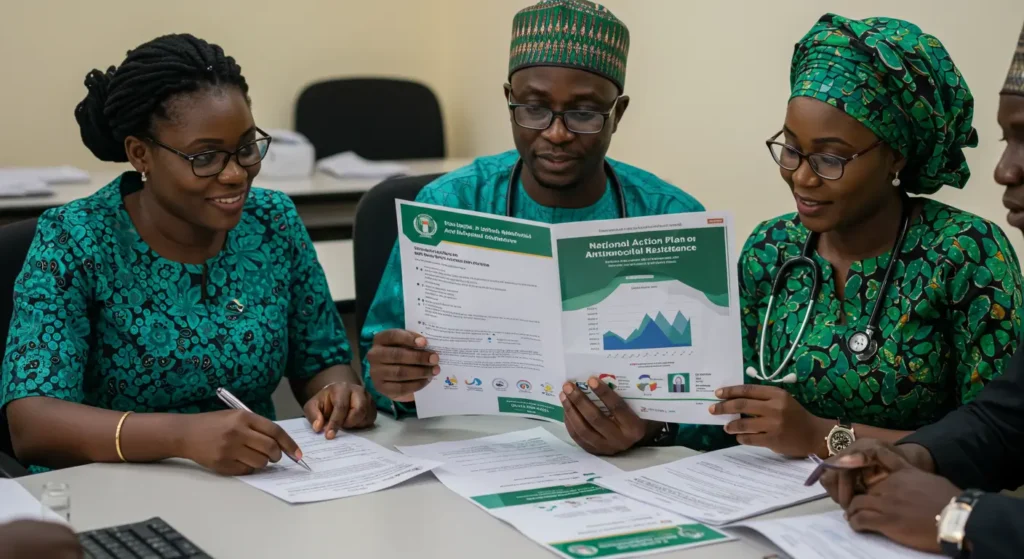
Imagine AMR as a sneaky shadow! Antimicrobial resistance! It sneaks in, turning simple infections into tough battles. Bacteria, viruses, fungi; they ignore meds that once worked. In Nigeria, it’s a growing concern. Self-medication, over-prescriptions, dirty water; folks don’t know the risks. Infections drag on; bills stack up; lives are lost. I chatted with a doctor in Lagos last month. He shook his head, saying, “We see kids with fevers that won’t quit! Antibiotics fail; it’s heartbreaking.” But Nigeria isn’t giving up! The Nigerian National Action Plan on Antimicrobial Resistance, or NAP-AMR, is a solid plan. It links health, farms, and the environment, launched in 2017 and updated to 2.0 in 2024. Let’s dive in; explore what it does, its successes, and what’s ahead!
Why AMR Demands Immediate Action in Nigeria
AMR isn’t just a health issue; it’s social, economic, and environmental. In Nigeria, habits drive it. Popping an antibiotic for a headache is common; skipping doses happens often. Bacteria survive, grow stronger, and spread. The result? Longer hospital stays, tougher illnesses, higher death rates. Globally, AMR was linked to nearly 5 million deaths in 2019! Nigeria’s region faces the worst, with about 115 deaths per 100,000 from AMR problems. Everyday infections, like pneumonia, become deadly.
My friend in Abuja raises chickens. He used antibiotics like feed, noting, “It kept them growing!” But resistance passed to people through food. Now, he’s changing; the plan encourages that. It pulls in everyone: doctors, farmers, you, me. The One Health approach connects us all, like pieces of a puzzle!
What the Nigerian National Action Plan on Antimicrobial Resistance Includes
NAP-AMR is a policy guide, tackling AMR across health, agriculture, and environment. “One Health” is its heart; humans, animals, ecosystems are linked. It began in 2017; the first phase covered basics like awareness, tracking, and smart med use. It ended in 2022 with only 44% completed, showing gaps in coordination and unclear costs. So, 2.0 started in October 2024: broader, with 6 objectives, 40 intervention areas, 143 activities, and 451 sub-tasks. It matches UN goals and President Tinubu’s health focus!
Key areas include:
- Building awareness: educate people via radio, schools, and bust myths.
- Boosting labs and tracking: surveillance systems catch resistance early.
- Cutting infections: better sanitation, vaccines, hygiene efforts.
- Smart antibiotic use: limit sales without scripts, train professionals.
- Research and updates: new studies, policy adjustments.
NNAST leads; the Nigerian National Antimicrobial Stewardship Taskforce coordinates ministries, NGOs, WHO. I joined a 2025 NNAST meeting in Abuja. Vets, doctors, and environmental experts worked on 2.0 tweaks. A vet shared, “We cut animal meds; vaccines work better,” which felt practical, like fixing a bike before a ride!
How Nigeria Tackles AMR Across Sectors
The plan covers all angles; no part is ignored.
Health Sector Efforts
Hospitals push stewardship: guidelines, trained staff, tests before prescribing reduce waste. My Lagos doctor friend’s clinic cut unnecessary antibiotics; patients heal faster!
Labs grow; surveillance in key areas provides data to spot trends.
Agricultural Changes
Farms relied on antibiotics for growth, prevention. Now? Training on hygiene, vaccines. In Kano, livestock co-ops reduced meds; yields stay steady, with less resistance in food.
Vets monitor; rural support expands.
Environmental Oversight
Drug waste in water breeds resistance. The plan monitors, improves disposal. A 2025 pilot in Port Harcourt cleaned wastewater; resistance dropped 30%! Communities benefit.
One Health ties it together, stopping spread like a dam holds water!
Key Achievements from the Nigerian National Action Plan on AMR
Progress is real:
- Surveillance up: systems in major hospitals; data flows.
- Awareness spreads: campaigns reach millions via radio, media, outreach.
- Teams collaborate: NNAST with NGOs, government; capacity builds.
- Rules tighten: over-counter sales curbed; regulations help.
- Research begins: local, global partners; new projects start.
NAP 1.0 set the base; 2.0 builds on it. Mid-2025 brings more labs. Nigeria hosts the 5th AMR Ministerial Conference in 2026, a leadership step!
My farmer friend says, “Chickens healthier; no extra meds,” a small win with big echoes.
NNAST’s Crucial Role in AMR Efforts
NNAST, the Nigerian National Antimicrobial Stewardship Taskforce, is the coordinator. NGOs, agencies, stakeholders follow its lead.
Responsibilities:
- Draft, review NAP-AMR.
- Connect ministries, WHO, NGOs.
- Lead education drives.
- Track trends, misuse.
- Advocate funding, enforcement.
Led by experts like Dr. Ifeoma Akinsete, it boosted surveillance in 2025, linking sectors. A NNAST member noted, “We fill gaps with teamwork,” vital glue!
Combating AMR in Nigeria: What’s Still Needed
Successes? Yes, but challenges remain:
- Engage communities: many misuse meds, unaware.
- Access tests: affordable labs are scarce; guessing lingers.
- Vet oversight: rural farms need consistent help.
- Enforce rules: stop illegal sales with stronger action.
- Fill data gaps: rural surveillance is weak.
Investment matters, plus political will and partnerships. My doctor friend adds, “Resources are tight; we keep pushing!”
How the Public Can Help Fight AMR
It’s not just experts; you play a part!
- No self-medication consult a doctor.
- Finish courses; take every dose.
- Don’t push for antibiotics.
- Stay clean: hands, food, water.
- Share knowledge with your circle.
NAP-AMR relies on us; one change ripples out!
Looking Ahead: AMR Response in Nigeria
Next steps? Community solutions, better diagnostics, tighter links. 2025 pilots shift behaviors; misuse drops.
Global praise for NNAST! Bacteria evolve, so plans must adapt, stay funded.
Hope shines, like the Lagos nurse says, “Tide’s turning,” step by step!
Final Thoughts
AMR is a tough climb, but Nigeria’s bold. NAP-AMR framework brings all sectors together: hospitals, farms, homes.
With NNAST, agencies, and people, antibiotics endure.
It depends on commitment, teamwork, choices; a safer future nears!
FAQs
Who leads Nigeria’s AMR plan?
NNAST, with the ministries of Health, Agriculture, and Environment.
What is the Nigerian National Action Plan on Antimicrobial Resistance?
A government policy to cut drug-resistant infections via education, regulation, and multi-sector work.
How does the plan benefit citizens?
Keeps antibiotics effective, lowers costs, protects from untreatable bugs.
How is agriculture involved in AMR control?
Farmers train on hygiene, vaccines, and less antibiotic use.
Is Nigeria making progress in combating AMR?
Yes, with increased surveillance, education, and regulations showing gains.


